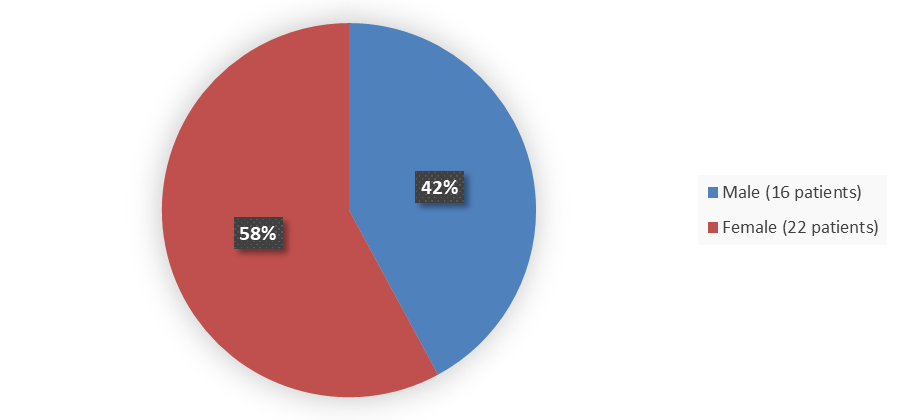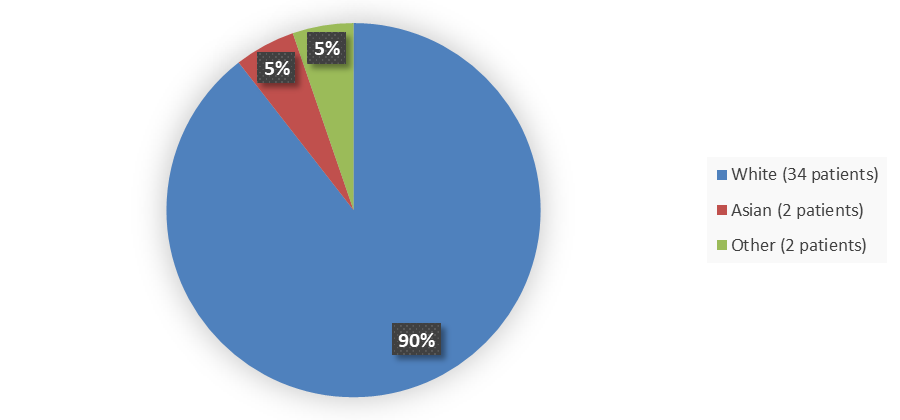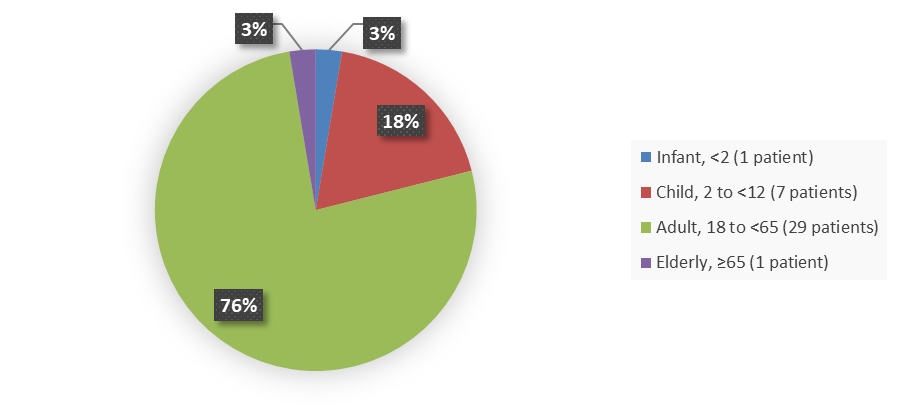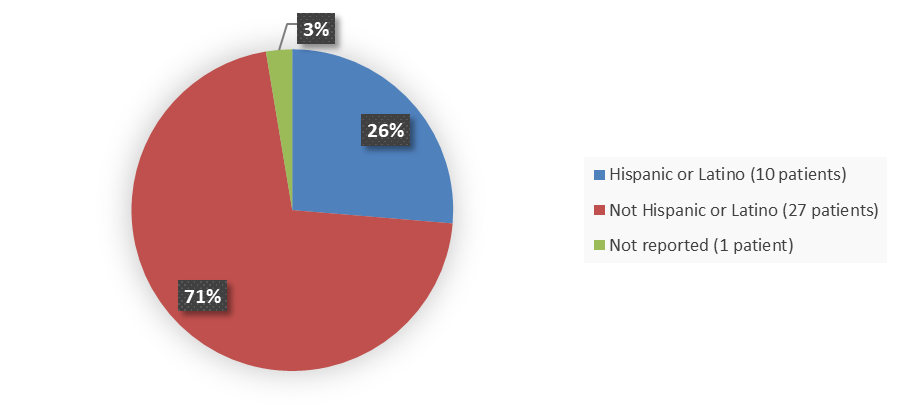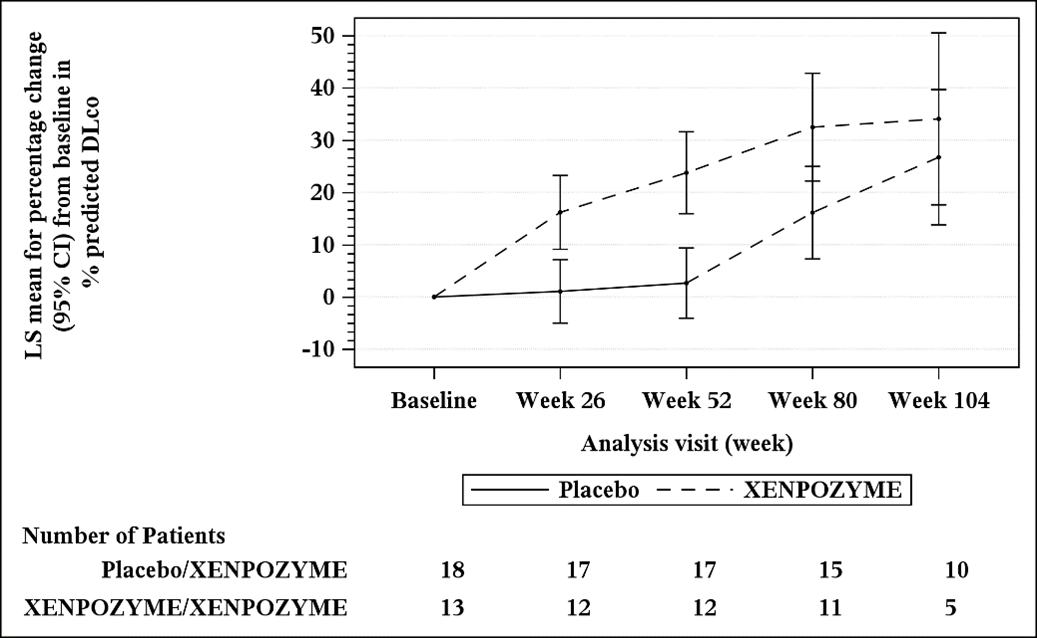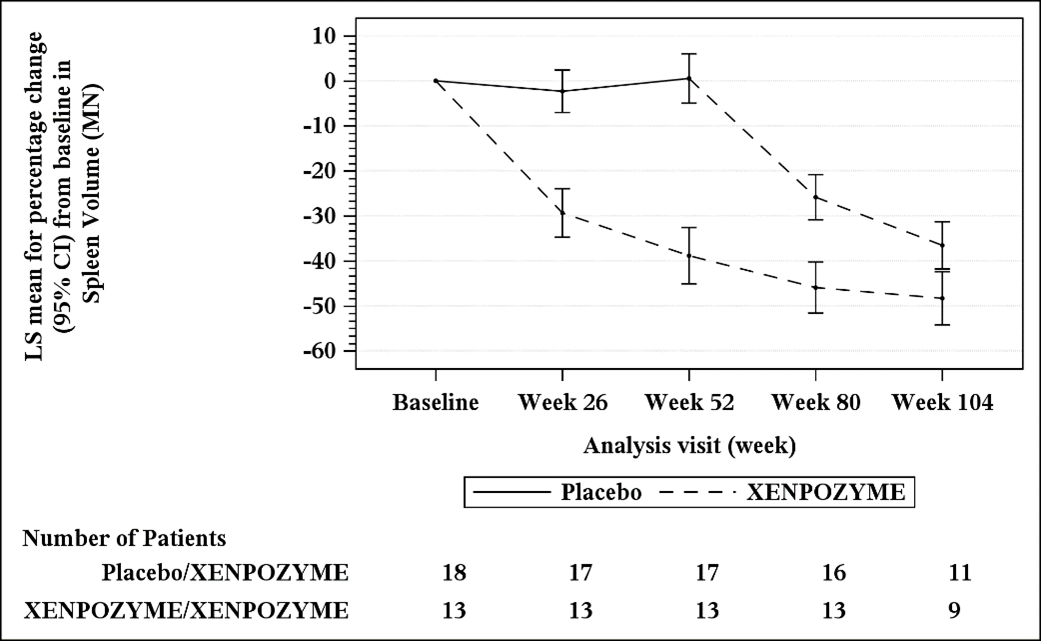Drug Trials Snapshots: XENPOZYME
HOW TO USE THIS SNAPSHOT
The information provided in Snapshots highlights who participated in the key clinical trials that supported the original FDA approval of this drug, and whether there were differences among sex, race, age, and ethnic groups. The “MORE INFO” bar shows more detailed, technical content for each section. The Snapshot is intended as one tool for consumers to use when discussing the risks and benefits of the drugs.
LIMITATIONS OF THIS SNAPSHOT
Do not rely on Snapshots to make decisions regarding medical care. Always speak to your healthcare provider about the benefits and risks of a drug.
Some of the information in this Snapshot is for presentation purposes and does not represent the approved conditions of use of this drug. Refer to the XENPOZYME Prescribing Information for all of the approved conditions of use of this drug (e.g., indication(s), population(s), dosing regimen(s), safety information).
Snapshots are limited to the information available at the time of the original approval of the drug and do not provide information on who participated in clinical trials that supported later approvals for additional uses of the drug (if applicable).
XENPOZYME (olipudase alfa-rpcp)
(ZEN-poh-zyme)
Genzyme Corporation
Approval date: August 31, 2022
DRUG TRIALS SNAPSHOT SUMMARY:
What is the drug for?
XENPOZYME is an enzyme replacement therapy that is used for the treatment of non-central nervous system manifestations of acid sphingomyelinase deficiency (ASMD) in adult and pediatric patients.
ASMD is a rare disease where patients have decreased activity of the enzyme sphingomyelinase, which breaks down a fatty lipid called sphingomyelin. Sphingomyelin can build up in organs and tissues, especially the lungs, liver, and spleen, causing them to stop working.
How is this drug used?
XENPOZYME is given by a healthcare provider using a needle placed in a vein (known as an intravenous infusion) every two weeks.
Who participated in the clinical trials?
XENPOZYME’s safety and efficacy data were derived from three clinical trials: Trial 1 in adult patients (NCT02004691), Trial 2 in pediatric patients (NCT02292654), and Trial 3 a long-term trial in pediatric patients (NCT02004704). These trials enrolled a total of 30 adult and 8 pediatric patients with ASMD. The trials were conducted at 30 sites in 24 countries around the world, including the United States.
How were the trials designed?
XENPOZYME was evaluated in three clinical trials of 38 patients with ASMD. Trial 1 evaluated the benefits and side effects of XENPOZYME in adult patients. Trial 2 evaluated the benefit and side effects of XENPOZYME in pediatric patients. Trial 3 was an extension of Trial 2 that evaluated benefit and side effects of XENPOZYME in pediatric patients.
In Trial 1, adult patients received either XENPOZYME or a placebo intravenously once every 2 weeks for 52 weeks. Neither the patients nor the healthcare providers knew which treatment was being given until after Week 52. In Trial 2, pediatric patients received XENPOZYME intravenously once every 2 weeks for 64 weeks.
Trial 3 was an open label long term trial that continued to evaluate pediatric patients that had completed Trial 2.
The benefit of XENPOZYME was evaluated by assessing the diffusion capacity of the lung for carbon monoxide, spleen volume, liver volume and platelet count.
DEMOGRAPHICS SNAPSHOT
Figure 1. Baseline Demographics by Sex (Trials 1, 2, and 3)
Source: Adapted from FDA Review
Figure 2. Baseline Demographics by Race (Trials 1, 2, and 3)
Source: Adapted from FDA Review
Figure 3. Baseline Demographics by Age (Trials 1, 2, and 3)
Source: Adapted from FDA Review
Figure 4. Baseline Demographics by Ethnicity (Trials 1, 2, and 3)
Who participated in the trials?
Table 1. Baseline Demographic and Clinical Characteristics, Safety Population, Adult Subjects Who Received Only Process C
| Characteristic | Adult PAP | Adult PAP+ETP | Pooled Adult N=30 |
||
|---|---|---|---|---|---|
| XENPO N=13 |
Placebo N=18 |
XENPO to XENPO N=13 |
Placebo to XENPO N=17 |
||
| Sex, n (%) | |||||
| Female | 5 (38.5) | 13 (72.2) | 5 (38.5) | 13 (76.5) | 18 (60.0) |
| Male | 8 (61.5) | >5 (27.8) | 8 (61.5) | 4 (23.5) | 12 (40.0) |
| >Age, years | |||||
| Mean (SD) | 34.4 (11.9) | 32.7 (17) | 34.4 (11.9) | 33.4 (17.2) | 33.8 (14.9) |
| Median (min, max) | 33 (20, 58) | 23.5 (18, 65) | 33 (20, 58) | 24 (18, 65) | 29 (18, 65) |
| Age group, years, n (%) | |||||
| ≥18 to <45 | 10 (76.9) | 13 (72.2) | 10 (76.9) | 12 (70.6) | 22 (73.3) |
| ≥45 to <65 | 3 (23.1) | 4 (22.2) | 3 (23.1) | 4 (23.5) | 7 (23.3) |
| ≥65 | 0 | 1 (5.6) | 0 | 1 (5.9) | 1 (3.3) |
| Race, n (%) | |||||
| White | 11 (84.6) | 16 (88.9) | 11 (84.6) | 15 (88.2) | 26 (86.7) |
| Asian | 1 (7.7) | 1 (5.6) | 1 (7.7) | 1 (5.9) | 2 (6.7) |
| Other | 1 (7.7) | 1 (5.6) | 1 (7.7) | 1 (5.9) | 2 (6.7) |
| Ethnicity, n (%) | |||||
| Hispanic or Latino | 4 (30.8) | 6 (33.3) | 4 (30.8) | 6 (35.3) | 10 (33.3) |
| Not Hispanic or Latino | 8 (61.5) | 12 (66.7) | 8 (61.5) | 11 (64.7) | 19 (63.3) |
| Not reported | 1 (7.7) | 0 | 1 (7.7) | 0 | 1 (3.3) |
Source: Adapted from FDA Review
Note: Adult subjects who ever received Process B were excluded from analysis.
Abbreviations: ETP, extended treatment; PAP, primary analysis period; SD, standard deviation; XENPO, XENPOZYME
Table 2. Baseline Demographic and Clinical Characteristics by Age Group, Safety Population, Pediatric Subjects Who Received Only Process C
| Characteristic | Child XENPOZYME N=7 |
Infant/Early Child XENPOZYME N=1 |
Pooled Pediatric XENPOZYME N=8 |
|---|---|---|---|
| Sex, n (%) | |||
| Female | 4 (57.1) | 0 | 4 (50.0) |
| Male | 3 (42.9) | 1 (100) | 4 (50.0) |
| Age, years | |||
| Mean (SD) | 6.7 (2.2) | 1 (NA) | 6 (2.9) |
| Median (min, max) | 7 (4, 10) | 1 (1, 1) | 6 (1, 10) |
| Age group, years, n (%) | |||
| <2 | 0 | 1 (100) | 1 (12.5) |
| ≥2 to <12 | 7 (100) | 0 | 7 (87.5) |
| Race, n (%) | |||
| White | 7 (100) | 1 (100) | 8 (100) |
| Ethnicity, n (%) | |||
| Not Hispanic or Latino | 7 (100) | 1 (100) | 8 (100) |
Source: Adapted from FDA Review
Note: Pediatric subjects who ever received Process B were excluded.
Abbreviations: N, number of patients in treatment group; n, number of patients with given characteristic; NA, not applicable; SD, standard deviation
What are the benefits of this drug?
XENPOZYME improved lung function and improved the size of the spleen in adult patients after 52 weeks of treatment. A similar effect was also seen in children after 64 weeks of treatment.
What are the benefits of this drug (results of trials used to assess efficacy)?
Table 3. Observed Value and Percentage Change From Baseline to Week 52 in Key Endpoints in Adult Patients With ASMD Type B, A/B on XENPOZYME or Placebo (Trial 1)
| Parameter | n | Placebo | n | XENPOZYME | Difference [95% CI] |
|---|---|---|---|---|---|
| DLco (% predicted) | |||||
| Mean at baseline (SD) | 18 | 48.5 (10.8) | 13 | 49.1 (9.7) | NA |
| Mean at Week 52 (SD) | 17 | 49.9 (11.1) | 12 | 59.4 (9.6) | NA |
| LS mean percent change at Week 52 (SE) | 17 | 3.0 (3.3) | 12 | 23.9 (3.8) | 20.9 (5.0)a [10.6, 31.2] |
| Spleen volume | |||||
| Mean (MN) at baseline (SD) | 18 | 11.2 (3.8) | 13 | 11.5 (4.7) | NA |
| Mean (MN) at Week 52 (SD) | 17 | 11.2 (4.2) | 13 | 7.2 (3.9) | NA |
| LS mean percent change (in MN) at Week 52 (SE) | 17 | 0.5 (2.62) | 13 | -38.9 (3.0) | -39.4 (4.0)b [-47.6, -31.2] |
| Liver volume | |||||
| Mean (MN) at baseline (SD) | 18 | 1.6 (0.5) | 13 | 1.4 (0.3) | NA |
| Mean (MN) at Week 52 (SD) | 17 | 1.6 (0.5) | 12 | 1.0 (0.2) | NA |
| LS mean percent change from baseline to Week 52 (SE) | 17 | -1.8 (2.7) | 12 | -26.5 (3.2) | -24.7 (4.2)b [-33.4, -16.1] |
| Platelet count (109/L) | |||||
| Mean at baseline (SD) | 18 | 115.6 (36.3) | 13 | 109.3 (30.6) | NA |
| Mean at Week 52 (SD) | 16 | 120.2 (43.2) | 13 | 126.4 (29.0) | NA |
| LS mean percent change from baseline to Week 52 (SE) | 16 | 2.7 (4.5) | 13 | 18.3 (5.0) | +15.6 (6.7)c [1.8, 29.4] |
Source: XENPOZYME Prescribing Information
Nominal p value: a p value=0.0003; b p value<0.0001; c p value=0.0280
Abbreviations: CI, confidence interval; DLco, diffusing capacity of the lungs for carbon monoxide; LS, least squares; MN, Markovian nonrandomized; NA, not applicable; SD, standard deviation; SE, standard error
Figure 5. Plot of the LS Means (95% CI) of the Percentage Change in DLco (% Predicted) From Baseline to Week 104 in Adult Patients With ASMD (Trial 1)
Source: XENPOZYME Prescribing Information
The vertical bars represent the 95% CIs for the LS means.
The LS means and 95% CIs are based on a mixed model for repeated measures approach, using data up to Week 104. Patients in placebo/XENPOZYME group received placebo by Week 52 and switched to XENPOZYME thereafter.
Abbreviations: ASMD, acid sphingomyelinase deficiency; CI, confidence interval; DLco, diffusing capacity of the lungs for carbon monoxide; LS, least squares
Figure 6. Plot of the LS Means (95% CI) of the Percentage Change in Spleen Volume (MN) From Baseline to Week 104 in Patients With ASMD (Trial 1)
Source: XENPOZYME Prescribing Information
The vertical bars represent the 95% CIs for the LS means.
The LS means and 95% CIs are based on a mixed model for repeated measures approach, using data up to Week 104. Patients in placebo/XENPOZYME group received placebo by Week 52 and switched to XENPOZYME thereafter.
Abbreviations: ASMD, acid sphingomyelinase deficiency; CI, confidence interval; LS, least squares; MN, Markovian nonrandomized
Table 4. Efficacy Results in XENPOZYME-Treated Pediatric Patients With ASMD (Trial 2)
| Parameter | n | Baseline Values | n | Week 52 Values | 95% CI |
|---|---|---|---|---|---|
| DLco (% predicted) | |||||
| Mean (SD) | 3 | 48.5 (8.1) | 3 | 70.9 (13.7) | |
| LS mean percent change* (SE) | 45.9 (22.7) | -12.5, 104.3 | |||
| Spleen volume | |||||
| Mean (MN) (SD) | 8 | 18.3 (5.6) | 8 | 9.50 (2.4) | |
| LS mean percent change (in MN) (SE) | -46.7 (3.6) | -55.5, -37.9 | |||
| Liver volume | |||||
| Mean (MN) (SD) | 8 | 2.5 (0.5) | 8 | 1.6 (0.3) | |
| LS mean percent change (in MN) (SE) | -38.1 (2.9) | -44.1, -32.0 | |||
| Platelet count (109/L) | |||||
| Mean (SD) | 8 | 136.7 (33.2) | 7 | 184.5 (54.2) | |
| LS mean percent change (SE) | 37.6 (13.7) | 8.5, 66.7 | |||
| Height z-scores | |||||
| Mean (SD) | 8 | -1.9 (0.8) | 7 | -1.5 (1.0) | |
| LS mean change (SE) | 0.5 (0.1) | 0.2, 0.8 |
Source: XENPOZYME Prescribing Information
Abbreviations: ASMD, acid sphingomyelinase deficiency; CI, confidence interval; DLco, diffusing capacity of the lungs for carbon monoxide; LS, least squares; MN, Markovian nonrandomized; SD, standard deviation; SE, standard error
Were there any differences in how well the drug worked in clinical trials among sex, race, and age?
- Sex: The number of patients in the trials was small; therefore, differences in how XENPOZYME worked among sexes could not be determined.
- Race: The number of patients in the trials was small; therefore, differences in how XENPOZYME worked among races could not be determined.
- Age: XENPOZYME worked similarly in all age groups studied.
What are the possible side effects?
XENPOZYME may cause serious side effects such as hypersensitivity reaction and infusion associated reactions because XENPOZYME is an enzyme replacement therapy.
What are the possible side effects (results of trials used to assess safety)?
Table 5. Adverse Reactions Occurring at a Frequency of >7% in Adult Patients With ASMD During the 52-Week Primary Analysis Period in Trial 1
| Adverse Reaction | XENPOZYME N=13 n (%) |
Placebo N=18 n (%) |
|---|---|---|
| Headache | 7 (54) | 8 (44) |
| Cough | 4 (31) | 2 (11) |
| Diarrhea | 2 (15) | 2 (11) |
| Hypotension | 2 (15) | 2 (11) |
| Ocular hyperemia | 2 (15) | 1 (6) |
| Erythema | 1 (8) | 1 (6) |
| Asthenia | 1 (8) | 1 (6) |
| Pharyngitis | 1 (8) | 1 (6) |
| Dyspnea | 1 (8) | 0 |
| Urticaria | 1 (8) | 0 |
| Papule | 1 (8) | 0 |
| Myalgia | 1 (8) | 0 |
| Throat irritation | 1 (8) | 0 |
| C-reactive protein abnormal | 1 (8) | 0 |
Source: XENPOZYME Prescribing Information
Abbreviations: ASMD, acid sphingomyelinase deficiency
Table 6. Adverse Reactions Occurring at a Frequency of ≥13% in XENPOZYME-Treated Pediatric Patients With ASMD in Trial 2* and Trial 3 for an Overall Observation Period of 2.5 to 3.2 Years
| Adverse Reactions | XENPOZYME N=8 n (%) |
|---|---|
| Pyrexia | 8 (100) |
| Cough | 6 (75) |
| Diarrhea | 6 (75) |
| Rhinitis | 6 (75) |
| Abdominal pain | 5 (53) |
| Vomiting | 4 (50) |
| Headache | 4 (50) |
| Urticaria | 4 (50) |
| Nausea | 3 (38) |
| Rash | 3 (38) |
| Arthralgia | 3 (38) |
| Pruritus | 2 (25) |
| Fatigue | 2 (25) |
| Pharyngitis | 2 (25) |
| C-reactive protein increased | 1 (13) |
| Hypotension | 1 (13) |
| Anaphylactic reaction | 1 (13) |
| Hypersensitivity | 1 (13) |
| Infusion site swelling | 1 (13) |
| Tachycardia | 1 (13) |
| Pharyngeal swelling | 1 (13) |
Source: XENPOZYME Prescribing Information
*Duration of treatment in Trial 2 was 64 weeks. All patients continued into Trial 3.
Abdominal pain includes abdominal pain and abdominal pain upper
Fatigue includes fatigue and asthenia
Rash includes rash and erythema
Abbreviations: ASMD, acid sphingomyelinase deficiency
Were there any differences in side effects among sex, race and age?
- Sex: The number of patients in the trials was small; therefore, differences in the occurrence of side effects among sexes could not be determined.
- Race: The number of patients in the trials was small; therefore, differences in the occurrence of side effects among races could not be determined.
- Age: Most of the patients were younger than 65 years of age. The occurrence of side effects was more frequent in patients younger than 18 years of age.
GLOSSARY
CLINICAL TRIAL: Voluntary research studies conducted in people and designed to answer specific questions about the safety or effectiveness of drugs, vaccines, other therapies, or new ways of using existing treatments.
COMPARATOR: A previously available treatment or placebo used in clinical trials that is compared to the actual drug being tested.
EFFICACY: How well the drug achieves the desired response when it is taken as described in a controlled clinical setting, such as during a clinical trial.
PLACEBO: An inactive substance or “sugar pill” that looks the same as, and is given the same way as, an active drug or treatment being tested. The effects of the active drug or treatment are compared to the effects of the placebo.
SUBGROUP: A subset of the population studied in a clinical trial. Demographic subsets include sex, race, and age groups.

